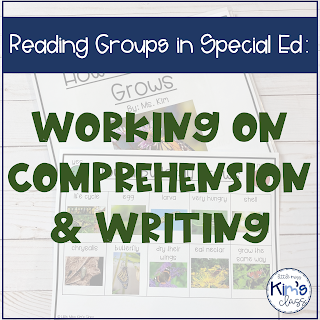Something I've always believed (and have seen to be true over my years in the classroom) is that even if students aren't "conventional readers," they can still do a lot during literacy instruction! We often have students who can't read (yet) in self-contained classrooms, but that doesn't mean we can't teach the five core components of reading: phonemic awareness, phonics & word study, reading comprehension, vocabulary and reading fluency.
We can (and should) teach our students more than just letter identification, letter sounds, sight words identification, and basic functional reading skills. There are SO many ways to work on students' IEP goals while exposing students to the common core and/or adapted curriculum content! It just takes some creativity and of course, differentiation.
I'm going to share some ideas for focusing on writing, comprehension and vocabulary when working with students with intensive needs. First let me say, I don't think there is one "right way" to run reading groups in special ed classrooms. It's important to hit all 5 core components of reading across the day, but boxed guided reading curricula often just don't work in our classrooms. If you want to read more about how we structure/ set up reading groups, check out this post.
So let's jump in... this is how we do it:

- Each group reads the same book for the entire week, similar to a repeated reading during traditional guided reading and shared reading lessons! Some students verbally read the books, while other students listen to a teacher read the book. Students are provided with a way to engage with the book during the reading. I use these communication/ answer boards during reading. Students can use the boards to match pictures, answer yes/ no questions, sequence the story, etc.
- Every day we finish reading the book, we answer differentiated comprehension questions. One level has pictures/ visuals to support students with answering questions and the other level has only words. Again, some students will read the question and answer options and other students will have a teacher read the question/ answer options to them.
- We do a different activity related to the repeated story each day. One day, we review vocabulary words from the book. We will read/ repeat the words, find the words in the book, define them, find them on our communication boards, etc. The main focus is for students to learn the vocabulary words, have exposure to the content and also work on their fine motor/ writing IEP goals. We practice writing the vocabulary words. Depending on needs, students are:
- tracing words
- copying words with boxes
- copying from a word bank with boxes or
- copying from a word bank.
- We also spend a day answering comprehension questions about the book. This is also highly differentiated so that all students can participate. A few of the concepts the comprehension worksheets include are:
- filling in the blank/ completing sentences
- identifying the main idea & key details
- answering direct recall questions
- identifying unfamiliar vocabulary
- making inferences
- As we read the questions to students, we will prompt students to go back and reference the book or communication boards to find the answers, if needed.
- Depending on needs, students are:
- tracing the answers
- picking the answer from a field of 2
- writing or copying the answer
- We also spend a day to work on using the vocabulary words in sentences. This is a great way to work on communication skills, grammar, fine motor/ writing, and comprehension/ vocabulary.
- Depending on needs, students are:
- tracing 2 sentences using the vocabulary words
- dictating 2 sentences to a teacher and then copying the sentences
- writing 2 sentences with a word bank
- These activities only fill 3 days of instruction. The other 2 days of reading groups, I typically use other comprehension activities I can find on TpT. They might be sequencing/ cut and paste activities or other writing prompts I can find. I like to give our students the structure and predictability of using similar worksheets 3 days a week and then mixing it up 2 days a week.
I hope this helps to give you ideas for working on comprehension & writing in your classroom! You can email me (littlemisskimsclass@gmail.com) or DM me on social media with any questions or ideas you have!
If you want a freebie/ sample of my book & writing/ comprehension extension pack, you can grab my Life Cycle of a Frog and extension pack for FREE here.
If you want to grab the entire bundle of 37 books and writing/ comprehension activities, click here!








